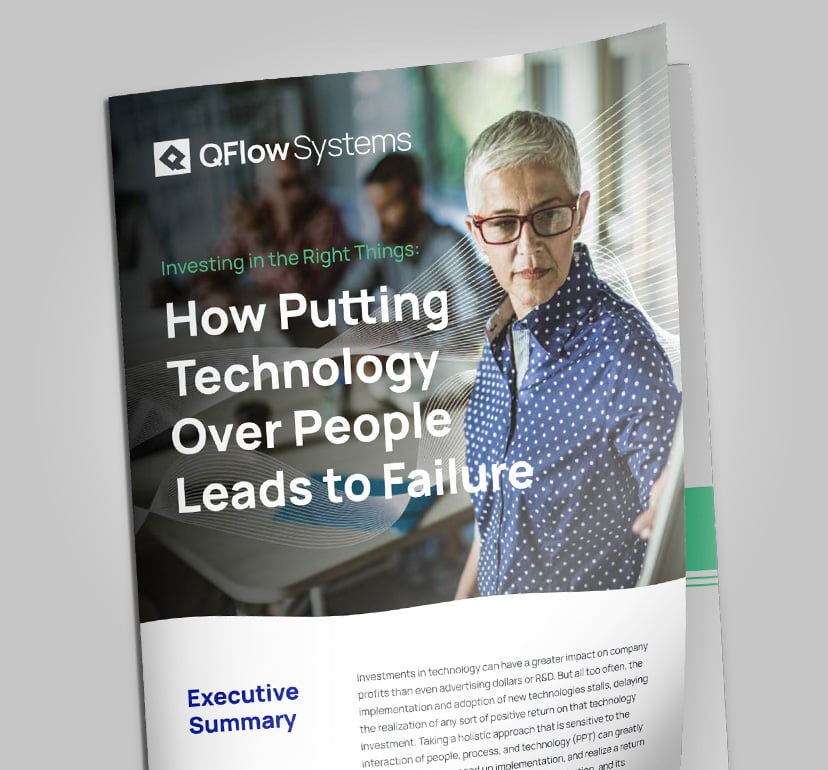Investing in the right technology products is one of the most effective ways to reduce operating costs and increase productivity. We’re used to seeing our own clients achieve a positive ROI in less than a year once they have a superior enterprise content management (ECM) solution. Unfortunately, though, even the best content services platform for electronic document management won’t automatically fix broken or inefficient processes.
There must be harmony between people, process, and technology to maximize efficiency and profits. For employees to adopt technology quickly and use it correctly, the solution has to function in a way that aligns with how they work.
Technology only becomes helpful enough to create ROI when it’s built with people and processes in mind. Instead of putting technology over people, the most successful businesses look at technology investment holistically. Before making any technology investment, it pays to have honest conversations with both internal teams and potential vendors to get their perspectives on your document management workflow.
When Software Upgrades Amplify Problems
When not managed correctly, technological upgrades can actually feel like a step in the wrong direction, adding to existing problems with workflows. For example, while email is a terrific technology, inefficient use of it can cause problems for businesses. The process of reading, writing, and organizing emails still requires a lot of manual work, which introduces opportunities for wasted time and human error.
In the context of document management, email can lead to versioning nightmares and security risks. At most companies, the process of sharing documents via email is also extremely inefficient. A McKinsey Global Institute (MGI) study found that employees spend 28% of their time reading and answering email, plus another 19% of their time searching for and gathering information.
The good news, according to that same study, is that 25% to 35% of the wasted time can be recovered through workflow automation and other improvements. The first step for business leaders is to analyze their processes, identifying inefficiencies that can be corrected.
What is true of email is true of other technologies as well: The technology is only as effective as the people and processes governing it. To ensure business process management technology is introduced correctly, watch out for some of the most common workflow problems while paying close attention to how changes impact employees and users. Prioritizing people at all times critical to making each technology product an asset, not a burden.
Addressing Workflow Gaps Takes Technology Plus Training
Most faulty workflows contain process gaps, which are inefficiencies and failures that make business workflows less than optimal. Sometimes it’s possible to fill the gaps with business process management software or workflow automation software, while other times better training is the solution. In most cases, it takes some combination of technology and training to close process gaps. To identify gaps in a document management process, consider common problem areas such as manual data entry, information retrieval, and workflow tracking.
Some of these gaps can be avoided by getting new technology set up properly in the first place, but process analysis should also be an ongoing habit. Whether you perform the analysis yourself, or you engage an outside partner like QFlow Systems, workflow analysis should include three basic steps:
- Talk to the people most involved in the workflow. Find out where they’re wasting time, which tasks are repetitive, and how problems are handled.
- Collect hard data. Some business process management software already tracks statistics, but you may have to find another way to gather knowledge. Look for information about which tasks in your workflow take the most time, and where bottlenecks form.
- Estimate the impact of each gap you identify. Once you know how much each process gap is affecting the bottom line, you can prioritize your changes and improvements.
After analyzing the workflow, you and your team will have an idea of the areas where technology will give you the biggest benefit. You’ll also have a good idea of where further training might be required to encourage employees to adopt the new system.
Aligning Process and Technology for Enterprise Content Management
Every company will require a somewhat different approach when it comes to executing the next steps. That said, communication is always key when aligning people, process, and technology. Work closely with employees to understand their workflow, and to see how they understand the interface. Involve team leaders to get their insights, then address as much feedback as possible during training sessions.
Continually identify opportunities for quick wins, and welcome constructive criticism on an ongoing basis. As you proceed, the quantity and quality of feedback received will keep your focus on the end users, which is paramount to encouraging and enforcing productive habits.
Help Employees and Users Create New Habits
The Harvard Business Review has found that end users might not adopt new technology unless the benefits are clear to them. It may be obvious to leaders how new technology will serve business goals, but it’s important for people at every level to understand why they’re changing processes. Once employees can grasp the benefits of new technology, both for the organization and for themselves, they become champions of change.
To avoid process issues with enterprise content management, and to achieve successful adoption, ask the right questions before settling on a vendor, then communicate your findings:
- How will the workflow automation software capture our company’s processes?
- Do you offer training on the content services platform, and who can we turn to if we have questions?
- Once the technology is implemented, how will you support user adoption?
How QFlow Addresses Process Issues
QFlow Systems starts with a customer-focused approach to create technology that serves people and expedites workflows. Our content services platform is backed by business process experts who support customers at every step along the way, from implementation and adoption to workflow automation and support. Our intuitive business process management software is designed to save employees and users time, and our team is prepared to help you implement the solutions with ease.
To learn more about our document management, records management, and business workflow management solutions, request a proof of concept or connect with a QFlow specialist.

